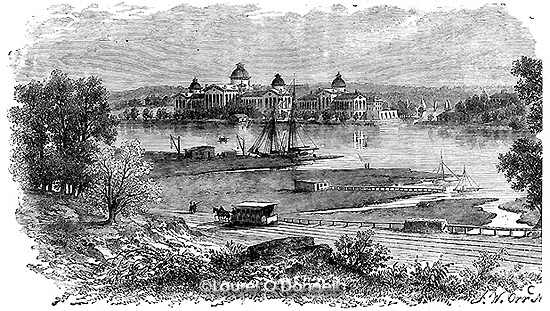|
|
Chapter VIII
Institutions of Randall's Island.
Society for the Reformation
of Juvenile Delinquents The House of Refuge, under the control of the "Society for the Reformation of Juvenile Delinquents," is situated on the southern portion of Randall's island, thirty acres of land being connected with the Institution. The Society, one of the most beneficent and humane in the world, was incorporated in 1824, with power of self-perpetuation. Among its managers have ranked many of the wisest and purest men of the State, who, without pecuniary compensation, have devoted a large portion of their time to its interests for years, and the records of their proceedings for nearly half a century exhibit the most gratifying results. Its first building was erected in Madison square, where it continued fifteen years, until the growing city forced the managers to evacuate, When they withdrew to Twenty-third street and East river. Here another fifteen were spent, until straitened for room, after much search and discussion, it was resolved to remove the whole to Randall's Island, which was substantially accomplished in 1854. Thousands of children in our great cities and towns are constantly growing up in ignorance arid neglect, many homes being little less than schools of vice. A consciousness of guilt, attended with imprisonment and disgrace, crushes what little of self-respect and laudable ambition may yet remain. To hurl these truant youth into a penitentiary, filled with mature and expert criminals, is but to cultivate their treacherous tendencies, and insure their final ruin. This society comes at the opportune moment to open the gates of its City of Refuge to those youthful unfortunates who are brought before the courts for petit offences, and receives them, NOT for punishment, but for instruction, discipline, and reformation. The departments are well arranged and most admirably conducted, presenting at every turn some striking example of system and tidiness. Visitors are politely received, but however distinguished they may be, no change is made in the daily routine of the Institution. Everything is on exhibition in its ordinary field parade.  House of Refuge—Randall's Island. The buildings are of brick, constructed on a magnificent scale in the Italian style, the two principal structures presenting a graceful fašade nearly a thousand feet in length, the whole completed at an expense of half a million: There are eight hundred and eighty-six spacious, well-ventilated dormitories, several finely arranged and amply furnished school-rooms, appropriate hospital departments, dining halls, kitchens, bakeries, laundries, sewing-rooms, elegant apartments for officers, and a model chapel, with seating for a thousand persons. In the rear stand the workshops, each thirty feet wide by one hundred and fifty long, and three stories high. The boys and girls are kept in separate buildings, their respective yards being divided by high walls, and the more advanced of the latter, who have been guilty of social crime, are carefully separated from the more youthful. Every child upon its admission is made to feel that the period of its detention rests with itself. Two general rules are at once and always inculcated. First, "Tell no lies." Secondly, "Always do the best you can." Every child is compelled to toil from six to eight hours every week-day, at some employment suited to its capacity, and to study from four to five hours, under competent teachers. The labor is designed to tame their fiery, vicious natures, to quicken attention, and favorably rouse all the dormant elements of their being. As moderate stints are introduced, affording opportunity to redeem extra time for reading and play, they toil with a cheerfulness and speed that is highly exhilarating. Thus sobered and awakened by toil, they return to their books, and keep pace with those who reside at home and attend the public schools of New York. Hundreds of young men and women are at work in the city and elsewhere rising to respectability and affluence by the steady habits and trades they acquired at the Institution, the former earning from twelve to twenty dollars per week, and the latter from four to twelve. Four grades of conduct have been introduced. Grade 1 is the highest, which every child must retain at least six weeks, and attain to the third class in school, before any application for indenture will be entertained from parents or friends. This grade must also be retained for one year, and the studies of the highest class mastered before one is discharged, and then a situation is provided. Grade 4 is the lowest, and is one of disgrace. |
|
260
:: Previous Page :: Next Page ::
:: Table of Contents :: :: New York State :: :: History Readings :: Books & articles appearing here are modified adaptations
from a private collection of vintage books & magazines. Reproduction of these pages is prohibited without written permission. © Laurel O’Donnell, 1996-2006.
|
|

